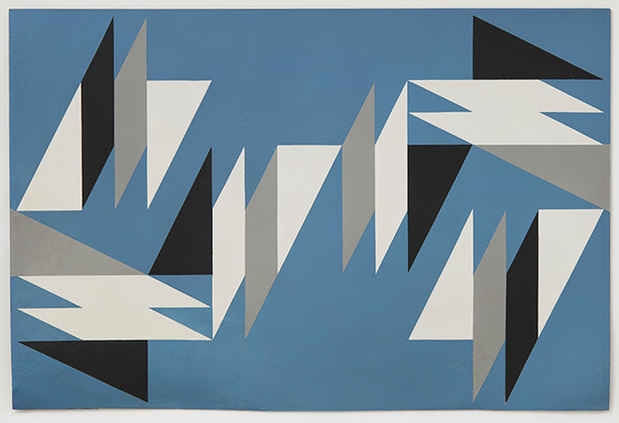Lygia Clark Exhibition
Luhring Augustine Gallery

[Image: Lygia Clark "Superficie Modulada" (1955-1957) Industrial paint on Eucatex, 24 5/16 x 36 1/16 in. Courtesy of Luhring Augustine, New York and Alison Jacques Gallery, London; © O Mundo de Lygia Clark-Associação Cultural, Rio de Janeiro.]
This event has ended.
Luhring Augustine presents its first solo exhibition of the pioneering Brazilian artist Lygia Clark. Organized in partnership with Alison Jacques Gallery, London, which co-represents the artist, this exhibition will feature Clark’s early drawings, collages, and paintings, as well as her iconic Bichos.
Lygia Clark (Belo Horizonte, Brazil, 1920 - Rio de Janeiro, Brazil, 1988) is one of the preeminent artists of the twentieth century, whose groundbreaking body of work reimagined the relationship between audience and the art object. A founding member of the 1950s Brazilian Neo-Concrete movement, Clark proposed a radical approach to thinking about painting by treating its pictorial surface as if it were a three-dimensional architectural space. Her studies under the Brazilian landscape architect Roberto Burle Marx and the French modernist painter Fernand Léger were deeply influential in this regard. Throughout her lifetime, Clark would remain a seminal figure of the international avant-garde, impacting future generations of artists with her transformative ideas surrounding the body, its presence and agency within a given environment.
Experimenting with modulations of form, color, and plane, Clark’s early abstract works challenged the canvas’ edge and extended the visual field of painting into the physical realm of the viewer. Her monochromatic compositions are adorned with interlocking shapes that explore various relationships, moving between figure-ground positions as they undergo perspectival shifts. Line and its properties are at the core of Clark’s investigations into positive and negative space. Through the interplay of adjacent and overlapping planes, she demonstrated that contours could delimit spatial fields as well as occupy the narrow voids in between.
Lines delineating the two-dimensional surfaces of her paintings find affinities with the creases and folds of her iconic Bichos, or critters. Constructed out of hinged metal planes, these versatile objects allowed for the audience to exercise authorship through participation. Clark’s reliance on the viewer to steer her sculptures through many possible configurations both jeopardized the autonomy of the art object and reconfigured her art as a performative, time-based event. Their open-endedness and iterative qualities affirmed her desire to overcome spatial and temporal boundaries, continuing to fulfill moments of continuity between artist, object, and viewer.
Retrospective exhibitions dedicated to Lygia Clark’s work include the critically acclaimed exhibition Lygia Clark: The Abandonment of Art 1948-1988, curated by Connie Butler and Luis Pérez-Oramas, at the Museum of Modern Art, New York in 2014; Lygia Clark: A Retrospective, at the Itaú Cultural, São Paulo, Brazil in 2012; and Lygia Clark, Fundació Antoni Tàpies, Barcelona in 1997, which travelled to the Musée d’Art Contemporain, Marseille, France; Serralves Foundation, Porto, Portugal; Palais des Beaux-Arts, Brussels, Belgium; and the Imperial Palace, Rio de Janeiro, Brazil. Important solo and group exhibitions during Clark’s lifetime include the early São Paulo Biennials (1953-1967); the Second Pilot Show of Kinetic Work, curated by Guy Brett at Signals Gallery, London in 1962; and a presentation, alongside Mira Schendel, at the XXXIV Bienale di Venezia in 1968. Recent exhibitions include Making and Unmaking, at the Camden Arts Centre, London in 2016; Life Itself, Stockholm in 2016; Lygia Clark: Work from the 1950s at Alison Jacques Gallery, London in 2016; Adventures of the Black Square, Abstract Art and Society 1915-2015, curated by Iwona Blazwick and Magnus Petersens at Whitechapel Art Gallery, London in 2015. A major presentation of Clark’s work as part of The Shadow of Color, curated by Rita Kersting, is on view at The Israel Museum in Jerusalem through April 2017. Clark’s work will be featured in the upcoming exhibitions Making Art Concrete: Works from Argentina and Brazil in the Colección Patricia Phelps de Cisneros at the J. Paul Getty Museum, Los Angeles, and Radical Women: Latin American Art, 1960-1985 at the Hammer Museum, Los Angeles as part of the greater initiative Pacific Standard Time. Clark’s work is represented in the permanent collections of the Museum of Modern Art, New York; the Art Institute of Chicago; Centre Pompidou, Paris; the Reina Sofía Museum, Madrid; the São Paulo Museum of Modern Art; the Museum of Modern Art Rio de Janeiro, among others.
Media
Schedule
from April 29, 2017 to June 17, 2017
Opening Reception on 2017-04-28 from 18:00 to 20:00